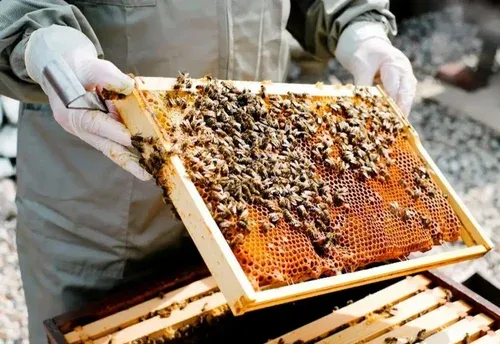Apiculture or Beekeeping Explain
Beekeeping or Apiculture is the maintenance of honey bees in commonly man-made hives by humans.
A beekeeper keeps bees to collect the product that the hive produces (including bee wax, pollens, and royal jelly) to pollinate crops or to produce honey for commercial purposes.
About 85% of the crop plants are cross-pollinated and for this colonies of honey bees placed in the field when the crop is in the flowering stage can set about the pollination abundance of the pollinator and help in the early setting of seeds resulting in a more uniform crop yield.
Classification of Bee
Phylum- Arthropoda
Class- Insecta
Sub-class- Pterygota
Order- Hymenoptera
Family- Apidae
Genus - Apis
Habit or Habitate of Apis (honeybee)
Honey bees are social insects they have a sucking type of mouth and this complete metamorphism for food they depend on nectar and Pollens. They make colonies for beehives they exhibit polymorphism and a good division of laborers One of the most important abilities of bees is to communicate the location of food with such perfection by a phenomenon which is called the language of the bees given by Karl von Frisch.
Apiculture, commonly known as beekeeping, is the practice of maintaining colonies of honeybees in hives to harvest honey, beeswax, pollen, and other bee products. Beekeeping has been an important agricultural practice for centuries, dating back to ancient civilizations.
In the United States, beekeeping is both a hobby and a commercial endeavor. It plays a crucial role in agriculture as honeybees are essential pollinators for many crops, including fruits, vegetables, and nuts. Beekeepers manage their colonies by providing suitable habitats, monitoring the health of the bees, and harvesting the products they produce.
Hive Management:
Beekeepers typically maintain one or more hives, artificial structures designed to house bee colonies. These hives provide shelter, protection, and a suitable environment for bees to thrive.
Bee Colony:
A bee colony consists of a queen bee, worker bees, and drones. The queen is responsible for laying eggs, while worker bees perform various tasks such as foraging for food, building and maintaining the hive, and caring for the larvae. Drones are male bees whose primary function is to mate with the queen.
Honey Production:
Honey is the primary product obtained from beekeeping. Bees collect nectar from flowers and convert it into honey through a process of regurgitation and evaporation. Beekeepers harvest honey by removing honeycombs from the hive and extracting the honey using specialized equipment such as honey extractors.
Beeswax:
Beeswax is another valuable product obtained from beekeeping. Bees produce beeswax to build the honeycomb structure within the hive. Beekeepers may collect beeswax by scraping it from the honeycomb and then purifying it for various uses, such as making candles, cosmetics, and pharmaceuticals.
Pollination Services:
Bees play a crucial role in pollinating flowering plants, including many agricultural crops. Beekeepers often provide pollination services to farmers by renting out their hives to pollinate crops such as almonds, apples, and berries. This service is vital for crop yield and quality.
Equipment and Tools:
Beekeepers use a variety of equipment and tools to manage their hives effectively. This may include protective clothing such as bee suits and veils, smokers to calm the bees during hive inspections, hive tools for manipulating frames and hive components, and extraction equipment for harvesting honey.
Health Management:
Beekeepers must monitor the health of their colonies to prevent and manage diseases and pests that can threaten bee populations. This may involve regular hive inspections, integrated pest management practices, and the use of treatments when necessary.
Environmental Considerations:
Sustainable beekeeping practices prioritize the well-being of bee colonies and their surrounding environment. Beekeepers should consider factors such as habitat loss, pesticide exposure, and climate change impacts on bee health and take measures to mitigate these risks.


No comments:
Post a Comment